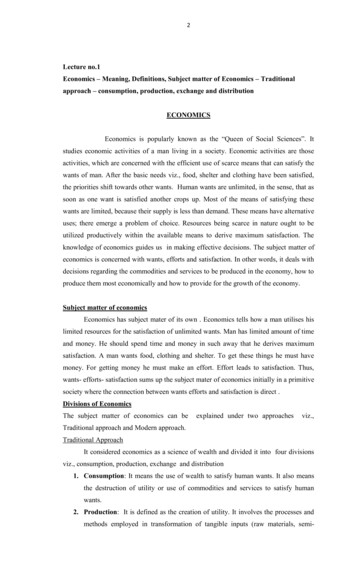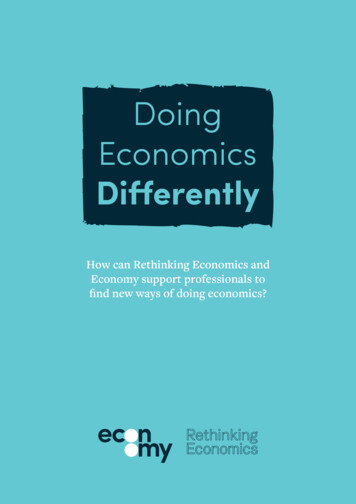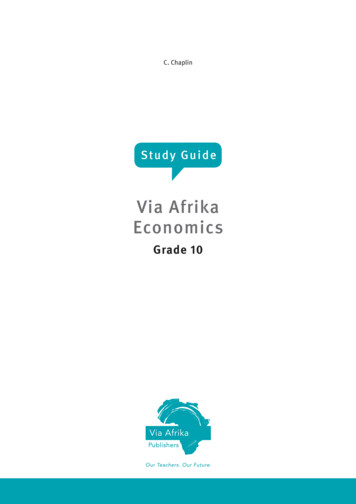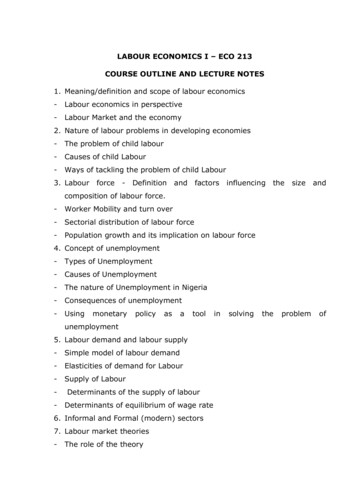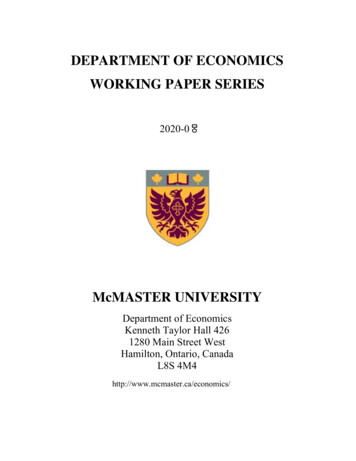
Transcription
DEPARTMENT OF ECONOMICSWORKING PAPER SERIES2020-0 McMASTER UNIVERSITYDepartment of EconomicsKenneth Taylor Hall 4261280 Main Street WestHamilton, Ontario, CanadaL8S 4M4http://www.mcmaster.ca/economics/
June 2020CHANGES AND STABILITY IN MARITAL STATUS:EVIDENCE FROM CANADIAN INCOME TAX RETURNSFrank T Denton, Byron G Spencer, and Terry A YipABSTRACTWe use a 20 percent longitudinal sample of Canadian personal income tax returns to explorepatterns and changes in marital status, with a focus on cohort behaviour. We define fivedifferent cohorts, each with a different starting age in 1995, and follow each over a 20-yeardata period. We consider and compare the changes in cohort patterns, giving special attentionto the stability of married and common law unions, and for that purpose distinguishing unionswith the same partner from those with a different one. Comparisons of cohort patterns show ashift toward an increased proportion reporting themselves as single or living in a common lawunion and a decreased proportion reporting married. The proportion married to the samepartner declines and the proportion married to a new partner increases, implying somereduction in marriage stability. Common law unions, more common at younger ages, appearunstable but much of the apparent instability is removed when common law unions that wouldtransition to married unions with the same partner are taken into account; common law as apremarital first stage appears to be increasingly common. At older ages the death of a partneris the major terminating factor at the end of a marriage, most prominently among males:widowhood (death of a partner) accounts for a much larger fraction of marriage terminationsfor women, death of self a much larger fraction for men, reflecting differences in lifeexpectancy and the younger age at marriage of women, on average.KEYWORDS -- Marital status, marital stability, longitudinal tax records, cohort behaviourJEL CODES –J12 – Marriage; Marital Dissolution; Family Structure; Domestic AbuseC63 – Computational Techniques; Simulation ModelingC81 – Methodology for Collecting, Estimating, and Organizing Microeconomic Data; Data Access1
INTRODUCTIONMarital status shares prominence with age and gender as a basic social, demographic,legal, and public administrative characteristic of an individual. All members of a population canbe classified according to marital status and national censuses and surveys ask them to reportit. Distributions at an aggregate level are calculated by statistical agencies and receive attentionas significant aspects of society, and the basis for comparisons with other jurisdictions andother times. Looking beneath the aggregates the patterns by which individuals change theirstatus are of interest. We consider changes at two levels in this paper, aggregate cross-sectiondistributions and, more especially, the changes in status of individual population cohorts asthey age.Our basic data source is the sample of personal income tax returns available (undersecured, anonymized access) from the Statistics Canada Longitudinal Administrative Databank(LAD). The LAD data represent roughly a twenty percent sample of all tax returns filed annuallywith the Canada Revenue Agency (CRA). Details of LAD, and how we use it, are discussed below(with source references) but we note here that individuals filing a tax return are required toreport their marital status according to the following six categories: single, married, commonlaw, divorced, separated, or widowed. Common law unions (as defined by CRA) are treated inthe same way as conventionally defined marital unions: we shall use the term partnership torefer to the combined category, married plus common law. The reporting categories, and howan individual might in fact select one to report are further discussed below.To our knowledge there have been no published results of research on distributions andchanges in marital status based explicitly on Canadian tax returns and our aim is to exploit this2
potentially valuable source of information. To that end the paper proceeds as follows. Webegin, in the next section, by describing in some detail the nature of the LAD tax return database and how we have adapted it for our purposes to obtain what we refer to as a filtered dataset. We then turn our attention to issues in the reporting of marital status, in particular howindividuals might interpret their personal circumstances in choosing a category to report andpossible issues of consistency and reliability in their responses. Following that up, thequinquennial census is another source of marital status information and as a rough check wecompare distributions from the two sources. (Milan, 2013, provides a careful analysis of maritalstatus based on earlier census data.)The analysis takes the form of examining the data in three ways. Our filtered LAD dataset spans a period of two decades, 1995 to 2015. It covers ages 25 and older and changes fromyear to year only by mortality and the entry of new 25-year-olds; it is thus consistent over thatperiod, as we explain in more detail, and is thus suitable especially for the construction ofcohort histories. We start the analysis then by considering briefly the cross-sectiondistributions of marital status in 1995, 2005, and 2015, and how they differ. The second andmore important way in which we examine the data (more important for the present paper)involves identifying individual cohorts at selected starting ages from 25 to 65 and observinghow their marital status distributions change over periods of twenty years in their lifetimes (ourdata range). The final way in which we examine the data focuses on the calculation andinterpretation of status transition probabilities, the probabilities for a given cohort of movingfrom one status group to another, including especially how they determine the formation,3
maintenance, and dissolution of partnership unions over time, married, common law, or thetwo combined.There is an extensive literature in economics, demography, and sociology on familyformation and dissolution, much of it drawing on the pioneering work of Becker (1973, 1974).With the rather few exceptions noted below, the empirical work is based on cross-sectionalsurvey data and much of it is focused on divorce. For example, Becker et al. (1977) use the 1967Survey of Economic Opportunity to estimate the probability of divorce from first marriage bymarriage duration for white men and women in the United States aged 35-55 at the time of thesurvey. They find, among other things, that divorce is less likely the higher the expectedearnings of men, the larger the number of children, and more likely the higher the expectedearnings of women, the younger the age at marriage, for those marrying outside their ownreligion, and for those confronted by unanticipated events. 1The present study is primarily descriptive: our purpose is to use a longitudinaladministrative data file with broad coverage of the adult population to document and describemarital status distributions and transitions as they occurred in Canada oer the two decadesending in 2015. We do not attempt to explain the transitions. Our goal rather is to present anddescribe them in novel and, we think, informative ways. However, to provide context we firstsummarize the results of a few related studies that are also based on longitudinal records.They explore a number of other aspects as well, including remarriage, and provide extensive references to theearlier literature.14
Much of the research has focused on divorce. Using the panel sample from the ItalianSurvey on Household Income and Wealth, De Paola and Gioia (2017) find that impatientindividuals (relatively high rates of time preference) who were married in 2004 are more likelyto be divorced in 2010 than their more patient counterparts, and those who were more riskaverse were less likely. Weagley et al. (2007), using the Panel Study of Income Dynamics, 19851992, find that the probability of divorce in the US decreases with the market work hours ofhusbands and the household work hours of wives. Bellani et al. (2018), using the German SocioEconomic Panel (1986-2009) and the US Panel Study of Income Dynamics (1986-2010), concludethat “the degree of inequity in couples’ allocation of paid and unpaid work influences maritalstability” in the US but not in West Germany (p. 1293). Based, in part, on the NationalLongitudinal Survey of Youth (1979-94) Bellou (2017) finds that male wage inequality has astabilizing effect on marriages.Eliason (2012) explores the relationship between divorce and job loss. His analysis isbased on four sets of Swedish records combined in an employee-employer linked data file. Thedata set includes “all married couples in which at least one of the spouses was displacedbecause of an establishment closure in 1987 or 1988 and a random sample of otherwisecomparable couples” (p. 1370), with the data period covering three years before thedisplacement and twelve years after. He estimates a 13 percent excess risk of divorce over the12-year period among couples in which the husband was displaced (p. 1365). Other temporarylife changes can also have an impact. Using data from the Danish Longitudinal Survey ofChildren for those born in 1995 linked to administrative data that track their parents’ marital5
status to 2006, Fallesen and Breen (2016) find that having a child with infantile colic“accelerates but does not increase the incidence of divorce” (p. 1378).Frimmel et al. (2013) analyse records from the Austrian Marriage Register with linkagesto other administrative records relating to divorce, mortality, and emigration. They find thatchanges in the age-, ethnicity-, religious-, and education-composition of marriages have notcaused the observed increase in divorce rates in Austria over the nearly four decades ending in2007. In contrast to the rich Austrian data set, Statistics Canada stopped publishing vitalstatistics on marriage and divorce in 2008. Margolis et al. (2019) explore the use of Canadianadministrative tax records as an alternative way to estimate divorce; they find that estimatesbased on tax returns substantially underestimate the number of divorces for the period before2008, largely because of lower counts among those under age 50. (Note: See our commentsbelow on the reporting of marital status, in particular divorce.)Mikolai and Kulu (2018) are concerned with the impact of divorce and separation onchanges in housing. Consistent with previous work they find, using 18 waves of the BritishHousehold Panel Survey (1991-2008), that separation does result in elevated mobility. They findalso that the risk of a residential move is higher even three years after separation.Yu and Kuo (2016) explore the impact of coresidence of adult children with theirparents. Using data from waves 1 through 5 of the Japan Life Course Panel Survey, relating tothe period 2007 through 2011, they find that “coresidence delays individuals’ transitions to firstmarriage mainly through decreasing their chances of forming romantic relationships” (p. 1314).Brown et al. (2019) assess factors that affect repartnering for those who divorce after age 506
(“gray divorces”). Using data from the 1998-2014 Health and Retirement Survey, they estimatethat about 22 percent of women and 37 percent of men repartnered within 10 year of divorce,more often through cohabitation than through remarriage.Others have investigated whether having children has a stabilizing impact onrelationships. Svarer and Veerner (2008), using the Integrated Database for Labour MarketResearch created by Statistics Denmark [Danish register data], conclude that after correcting forselectivity bias arising from the fertility decision “children themselves do not have a positiveeffect on the duration of the relationship” (p 413). Bellido et al. (2016) add another dimensionin their analysis of 24 waves of the US National Longitudinal Study of Youth. After accountingfor the endogeneity of fertility decisions, they conclude that “each additional child conceivedwithin marriage reduces by 0.19 the probability of marital disruption” while “children conceivedbefore marriage increase the probability by about 0.1” (p. 29).Cohabitation has become increasingly common as a form of first partnership. Ermischand Francesconi (2000) use the British Household Panel Study to investigate the stability ofcohabiting unions; they find that cohabitation tends to be of relatively short duration before atransition to marriage or dissolution. Kuo and Raley (2016) also focus on cohabitors; theiranalysis of two cycles of the US National Study of Family Growth finds that marriage ratesamong cohabitors have declined steeply among those with no college degree. Svarer (2004),using data from the Danish Integrated Database for Labour Market Research, concludes,contrary to almost all prior studies, that premarital cohabitation is associated with a lower riskof divorce and, furthermore, that the longer the period of cohabitation the lower the risk. The7
evidence in the US remains inconclusive. Kuperberg (2018), using data from the National Surveyof Family Growth, 1986-2015, concludes that “since 2000 premarital cohabitation has actuallybeen associated with a lower rate of divorce” while Rosenfeld and Roesler (2019), working withthe same survey, find a lower marital dissolution rate in the first year of marriage for coupleswho cohabited before marriage but are less confident about how durable the effect is.2. TAX RETURNS AS A DATA SOURCEThe basic source for our data is Statistics Canada’s Longitudinal Administrative Databank(Statistics Canada, 2018). LAD incorporates an approximately 20 percent sample of personalincome tax returns collected by the Canada Revenue Agency (CRA), dating back to 1982. Newreturns are sampled year by year so as to maintain the roughly 20 percent proportion andunique taxpayer identification is provided by social Insurance numbers. A longitudinal recordthus exists for every taxpayer. Access to LAD is made available for research purposes understrict security that ensures anonymity and confidentiality of individual returns.We have made use of LAD in the following way: we “filtered” the LAD sample, as weshall put it. Not all adults in the population are required to file a tax return every year, based onincome criteria, and the ratio of taxpayers to adult population was somewhat lower in theearlier years of sampling. However the ratio increased over time and by the early 1990staxpayers 25 to 80 years of age represented more that 95 percent of the correspondingpopulation. We chose 25 as the starting age for our analysis and 1995 as the initial year, subjectto the requirement that each individual must have filed in that year and the previous two. Atthe commencement of the study 2015 was the latest year for which data were available and so8
the period of analysis became 1995 to 2015. We stipulated that every individual in our filteredsample must have continued to file every year in that period and remain in LAD unless removedby death. Two results of these requirements for our filtered sample are (1) that it excludes allpersons immigrating to Canada after 1995 other than those who turn 25 while in Canada and(2) it excludes all persons present in Canada at the start of the period but who emigratedbefore the end of it. Thus turning 25 became the only way of entering the filtered sample anddeath the only way of leaving it. Other minor adjustments included correcting forinconsistencies in the reporting of age from one year to another (reporting of date of birthmade that possible) and excluding individuals for whom gender was inconsistently reported.The final result is a filtered sample representing a population defined in 1995 and changing overtwo decades thereafter only by natural aging (including turning 25) and mortality. It is thus amore consistent population from the point of view of identifying cohorts and tracking theirbehaviour over time.3. THE REPORTING OF MARITAL STATUSA taxpayer is asked to report marital status on the tax return by choosing one of sixcategories: single, married, common law, widowed, separated, or divorced. CRA has its ownadministrative definitions of these categories in determining tax implications but there may stillbe latitude for differing interpretations depending on an individual’s circumstances. Weconsider each status category in light of that possibility, noting first (in summary form) theintended definition and then possible reinterpretations. (The administrative definitions can befound in Canada, 2019.) What prompts us to offer this discussion is in part the fact that the data9
show changes in status, over a time interval, from one category to every other category on thelist, including seemingly inadmissible changes. Some of such changes could have to do with thelength of the interval: single to separated, for example, could in fact reflect a very short-livedmarriage. But we suspect that some of the category choices, and changes in them, may beattributable to the latitude of interpretation provided to those selecting them.Status Single: The intended definition is “never married, with none of the other categoriesapplicable”. Assuming no tax implications (or an ignorance of the implications) someonewidowed, divorced, or separated might nevertheless consider him/herself to now be single, andchoose this category accordingly. Someone who considered him/herself to have been in acommon law relationship now dissolved might of course make a similar choice, which would bein conformity with the definitions.Status Married: This would appear straightforward: “married means legally married” althoughthere are still tax qualifications regarding being married but living apart for reasons other thanmarriage breakdown. However, one can imagine a couple regarding themselves as married “forall intents and purposes” from a social point of view and thus choosing this category to report,rather than common law.Status Common Law: The basic definition is “living in a conjugal relationship with someone towhom you are not legally married” but there may be additional conditions for administrativerecognition. CRA requires the relationship to have existed for at least 12 consecutive months,with modifications to allow for the presence of children. Leaving aside a formal definition, twoindividuals may regard their relationship as equivalent to marriage and, forced to choose from10
among the six categories, select that one – or, to put it differently, select married on the basisof “for all intents and purposes” reasoning. (Recognition of a tax advantage one way or anothermight of course affect the decision.) A perhaps more contentious issue is how to classify oneselfif the relationship breaks down (see below).Status Widowed: The intended definition here is obvious - one’s spouse has died and thesurvivor has not remarried – but the actual category that an individual might report is not soobvious. Depending on circumstances, including the nature of the previous relationship,someone might prefer to choose single rather than widowed (especially a younger person).Someone separated or divorced at the time of the spouse’s death might do the same. Ingeneral, whether to report “widowed” as one’s status may depend on personal circumstancesand preferences.Status Separated: Separation from a marriage partner may be legally recognized or, informally,a matter of personal opinion. One can imagine some variation in the choice (or not) of thiscategory by an individual filling out the tax form. (As always, recognition or ignorance of taximplications may play a role.) It seems unlikely that separation would be chosen with anyfrequency after the breakup of a common law relationship so the category applies principally toa legal marriage.Status Divorced: Divorce has a precise legal definition but whether to choose that category onthe tax form may be optional (recognized tax implications aside). Some individuals might preferto think of themselves as single again, and so report. Someone who has established a new11
common law relationship might be expected to report accordingly, and of course a remarriagewould be reported as married.The foregoing category-by-category observations have a single purpose: to make thepoint that the choice of a category to report is not rigidly determined by precise definitions.There is room for individual circumstances and preferences to play a role and the analysis thatfollows can be viewed to a not insignificant degree as an analysis of patterns and changes inwhat people (taxpayers in this case) regard as their marital status. There are legal boundariesaround the categories to some extent but the boundaries may be somewhat fuzzy. That is nodoubt true of marital status data from any other source as well (census data, for example) anddoes not mean that the analysis is less meaningful. How a society views its marital statescollectively is still an interesting topic.4. COMPARISON WITH CENSUS RESULTSOur data period terminates in 2015. The nearest census year is 2016 and we comparethe marital status distributions from our filtered LAD sample with those of that census. Maritalstatus is reported as of December 31 for tax purposes and the 2016 census enumeration datewas May 10. Thus the two data sources differ in reference date by just over four months. Wecompare the distributions from the two in Table 1.The distributions are generally similar but there are some differences, which is notsurprising. The framing and circumstances of the two methods of data collection differconsiderably. Also, our filtering of LAD induces a difference in composition of the population,most notably perhaps by the removal of all immigrants who entered the country in the two12
previous decades but also by the exclusion of persons who did not file a tax return in everyyear. The proportion of men reporting themselves as married is about four percentage pointshigher in the filtered LAD data than in the census and the proportion of women reporting singleis also about four percentage points higher. There are offsetting differences in other categories.5. CROSS-SECTION DISTRIBUTIONSA quick look at the overall distribution by marital status and how it changed over twodecades before moving on to the analysis of cohort distributions and transitions, the principalfocus of this paper. Table 2 shows the proportions in 1995, 2005, and 2015. It is apparent thatthe distribution shifted in some ways in each of the two decades. The proportion singleincreased significantly and the proportion married declined. At the same time the proportionreporting common law relationships increased, more than doubling from 1995 to 2015, andthus offsetting the marriage decline to some extent in terms of combined partnershiprelationships. The proportion reporting widowhood was consistently much lower for men thanwomen (reflecting differences in life expectancy) and declined somewhat for women. Thecombined divorced/separated proportion was roughly stable for each sex.6. COHORT DISTRIBUTIONSIdeally in analysing cohort marital status patterns one would like to be able to observeprogressions from early adulthood to the termination of life but that would require longitudinaldata spanning a much longer period than ours. What we do therefore is the following. Weidentify several cohorts, each beginning in the year 1995, and thus having different starting13
ages, and follow each one over the next twenty years of its life, ending in 2015 (ages 25 to 45,35 to 55, for examples). We present the results in various ways in the tables that follow.The first round of analysis involves looking at the proportionate distribution of each offive cohorts as it evolves over the cohort’s observable 20-year life segment, separately formales and females. The results are shown first, in Table 3, with deceased excluded from the listof marital status categories, and then, in Table 4, with deceased included. The idea here is tolook first at the distribution of living members of a cohort and then to see how the distributionis affected by the addition of the death of a respondent, in particular as an event thatterminates a marriage or common law union. The cohorts in Table 3 thus include only thosewho were still alive after twenty years; the cohorts of Table 4 include as well those who haddied by the end of that period. Aside from this difference the two tables are identical instructure. The selection of cohorts and the five-year age intervals (the columns) are the same.An important alteration of the conventional marital status categories (in both tables) isthe splitting of married into two components, married to the same person or married to adifferent person, and similarly for common law. ‘Married to same person’ means that either (1)the married spouse is the same as the first married spouse within the 20-year cohort period or(2) the married spouse is the same as the first common law partner within that period, thusincluding in the “married same” category common law unions that were converted to marriageunions. “Common law same” means simply the same as the first common law partner withinthe period. (“Within the period” is an important qualification; the data series are not longenough to permit us to identify overall lifetime first partners.)14
The separate distributions for males and females in the tables are not procedurallycorrelated. They are derived independently from the LAD sample data and may reflectdifferences in the interpretation of alternative categories in making a selection, along the linesdiscussed previously. To some extent they may also reflect differences in the effects of filteringon male and female tax filer respondents.The youngest cohort in Table 3 (and other tables) is aged 25 to 45, the period of lifewhen the marital status structure of a cohort evolves most rapidly. At age 25 some 67 percentof male cohort members are recorded as single, 22 percent as married. For the correspondingfemale cohort the percentages are 50 and 35, the male/female differences being consistentwith the common (statistical) observation that women are younger than men at first marriage,on average; by age 35 the proportions are more closely aligned. (Note that marriage at theinitial age of a cohort falls necessarily into the married same category.) Common law unions(same plus different) are in the general range of 10 to 15 percent. By age 45 about 63 percentof men in their cohort have retained the original partners (married same plus common lawsame) and 12 percent have changed (married different plus common law different). For womenthe percentages are 57 and 12.The five cohorts in Table 3 are of different initial ages but looking at them collectively,and deferring a more careful treatment of cohort differences to later, we can make a roughsketch of typical lifetime patterns. Here is our sketch. Starting from the transfers of single topartnership status at younger ages the proportion single continues to fall with age, theproportion married to rise, and the proportion common law to decline as our sketch cohort15
grows older. Within the category married the proportion with a change in partner during thetwenty years reaches 7 percent for the youngest cohort but for older ones it never exceeds 4percent and is generally much lower. One might think of this as a conditional measure ofmarital stability – conditional on a twenty-year period. (The issue of stability is considered moreexplicitly in the next section.) Overall, the percentage reporting as married in our sketchreaches a high in the mid 70s to low 80s for males and a combined partnership proportion inthe neighbourhood of 80. For females the percentage highs are somewhat lower, upper 60s inthe first case, low 70s in the second. Terminated marriages represented by divorce/separation,and reported by males, run around 7 to 9 percent up until the very oldest ages; as reported byfemales the proportion is higher, around 11 to 14 percent. Table 3 excludes deceased as acategory to be reported. It includes widowhood though, indicating the death of a spouse as aterminal event; that is of little effect at younger ages but of major significance for the oldercohorts, especially for women. At 75 the male widowhood proportion is 8 percent for thesecond oldest cohort, 10 percent for the oldest; the corresponding percentages for women aremuch higher, 28 percent and 40 percent. These large male/female differences reflect both thelonger life expectancy of women and the fact that women marry older men, on average.The results in Table 4, which includes deceased as a category, as well as widowhood, aregenerally similar to those of Table 3 for younger cohorts but sharply different for the oldestones. (Reminder: The cohorts of Table 3 represent only those members who survive to the endof a period; those of Table 4 represent all members, including those who die within the period.)For men the deceased proportion at age 75 in Table 4 is about 25 percent, for women 14 to 16percent, depending on which of the two oldest cohorts one looks at. For men the widowed16
proportion is now 6 or 7 percent, for women 24 to 34 percent. Again, the male/femaledifferences reflect life expectancies and age at marriage.Although limited in duration the twenty-year histories in Tables 3 and 4 overlap partiallyin age and thus provide some evidence of changes in cohort patterns. (Age 50 is included fortwo different cohorts, age 45 for three, for examples, and so changes at those ages can beobserved.) Although the period is only twenty years the differences among cohorts aresubstantial. The proportions single and common law increased and the proportion marrieddecreased: for the cohort starting at age 45 (thus born in 1950), 74 perc
report their marital status according to the following six categories: single, married, common law, divorced, separated, or widowed. Common law unions (as defined by CRA) are treated in the same way as conventionally defined marital unions: we shall use the term partnership to refer to the combined category, married plus common law.




